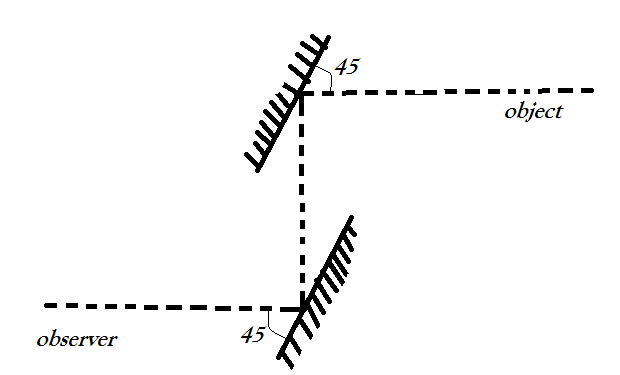
In the arrangement shown in the figure the image of extended object as seen by the observer is:

A.Real and inverted
B.Real and erect
C.Virtual and inverted
D.Virtual and erect

Answer
576k+ views
Hint:: A plane mirror makes an image of objects in front of the mirror; these images appear to be behind the plane in which the mirror lies.
A straight line drawn from part of an object to the corresponding part of its image makes a right angle with, and is bisected by, the surface of the plane mirror.
Complete step by step solution:
The image formed by a plane mirror is always virtual (meaning that the light rays do not actually come from the image), upright, and of the same shape and size as the object it is reflecting.
As we know that a plane mirror always forms a virtual and erect image.
Therefore, clearly from the figure,
We can say that the rays that emerge from the top of an extended source get reflected to the second mirror and then reach the observer and since a plane mirror always forms a virtual and erect image.
So, this results in giving an erect image.
Also plane mirrors always form virtual images.
Thus even such a combination gives a virtual image.
Hence the option D (virtual and erect) will be the required answer.
Note: Only plane mirrors always form virtual and erect images but note that spherical mirrors that are concave mirrors can generally form real and inverted images and convex mirrors can form virtual and erect images.
A straight line drawn from part of an object to the corresponding part of its image makes a right angle with, and is bisected by, the surface of the plane mirror.
Complete step by step solution:
The image formed by a plane mirror is always virtual (meaning that the light rays do not actually come from the image), upright, and of the same shape and size as the object it is reflecting.
As we know that a plane mirror always forms a virtual and erect image.
Therefore, clearly from the figure,
We can say that the rays that emerge from the top of an extended source get reflected to the second mirror and then reach the observer and since a plane mirror always forms a virtual and erect image.
So, this results in giving an erect image.
Also plane mirrors always form virtual images.
Thus even such a combination gives a virtual image.
Hence the option D (virtual and erect) will be the required answer.
Note: Only plane mirrors always form virtual and erect images but note that spherical mirrors that are concave mirrors can generally form real and inverted images and convex mirrors can form virtual and erect images.
Recently Updated Pages
Master Class 8 Maths: Engaging Questions & Answers for Success

Class 8 Question and Answer - Your Ultimate Solutions Guide

Master Class 7 Maths: Engaging Questions & Answers for Success

Class 7 Question and Answer - Your Ultimate Solutions Guide

Master Class 6 Maths: Engaging Questions & Answers for Success

Class 6 Question and Answer - Your Ultimate Solutions Guide

Trending doubts
Write a letter to the principal requesting him to grant class 10 english CBSE

Why is there a time difference of about 5 hours between class 10 social science CBSE

What is the median of the first 10 natural numbers class 10 maths CBSE

The Equation xxx + 2 is Satisfied when x is Equal to Class 10 Maths

Discuss the main reasons for poverty in India

10 examples of evaporation in daily life with explanations




